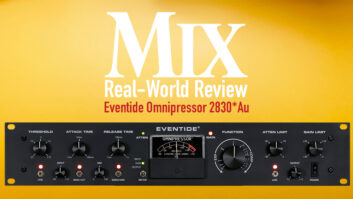Based on its hardware units from the 1970s, Eventide’s Instant Phaser and Instant Flanger MkII faithfully re-create these classic boxes while adding a number of modern features. There are four ways to control the phasing in the Instant Phaser: an LFO that ranges from 20 Hz all the way down to .01 Hz (or from a 64th note down to 16 bars in sync mode); an envelope follower; manual mode, where the phasing is controlled by manually moving the large knob in the middle of the interface; and remote mode, where it can be controlled by MIDI.
Real-World Review: McDSP 6060 Ultimate Module Collection
I found the slower speeds on the oscillator to be perfect for adding some gentle movement and interest to otherwise static pads. I used the envelope follower on percussion loops to trigger maximum phasing effect only on the louder hits. An interesting use I found for manual mode was keeping the phase knob in a fixed position, creating unique filtering/EQ effects to shape the tone of guitar and synth tracks.
One of my favorite controls on the phaser is the age knob. As you turn the knob up, it emulates the aging of the internal components of the phaser. At 0, it sounds like a brand-new unit straight from the factory. Turn it to 25 percent and it sounds how a unit built in 1972 would sound today. Crank it up even farther and things get interesting as it emulates what one of these units will sound like far in the future, after years of wear.
The Instant Flanger can be controlled by the same four sources as the phaser: a 20 Hz to 0.01 Hz oscillator, an envelope follower, remote, and manual mode. I had a lot of fun with manual mode while mixing. On drum tracks, I would automate the knob up to accentuate certain sections with extra flanging. My favorite feature on the flanger, however, is its “Wide” mode.
This simulates the use of both the main and aux output on the original device, which creates a stereo effect. This was incredibly handy because most of our tracks featured a mono analog synthesizer (the Roland SE-02). I was able to use the flanger to push leads out of the center, leaving room for other tracks, and create incredibly wide pads, all from a mono source.
Eventide • www.eventide.com







